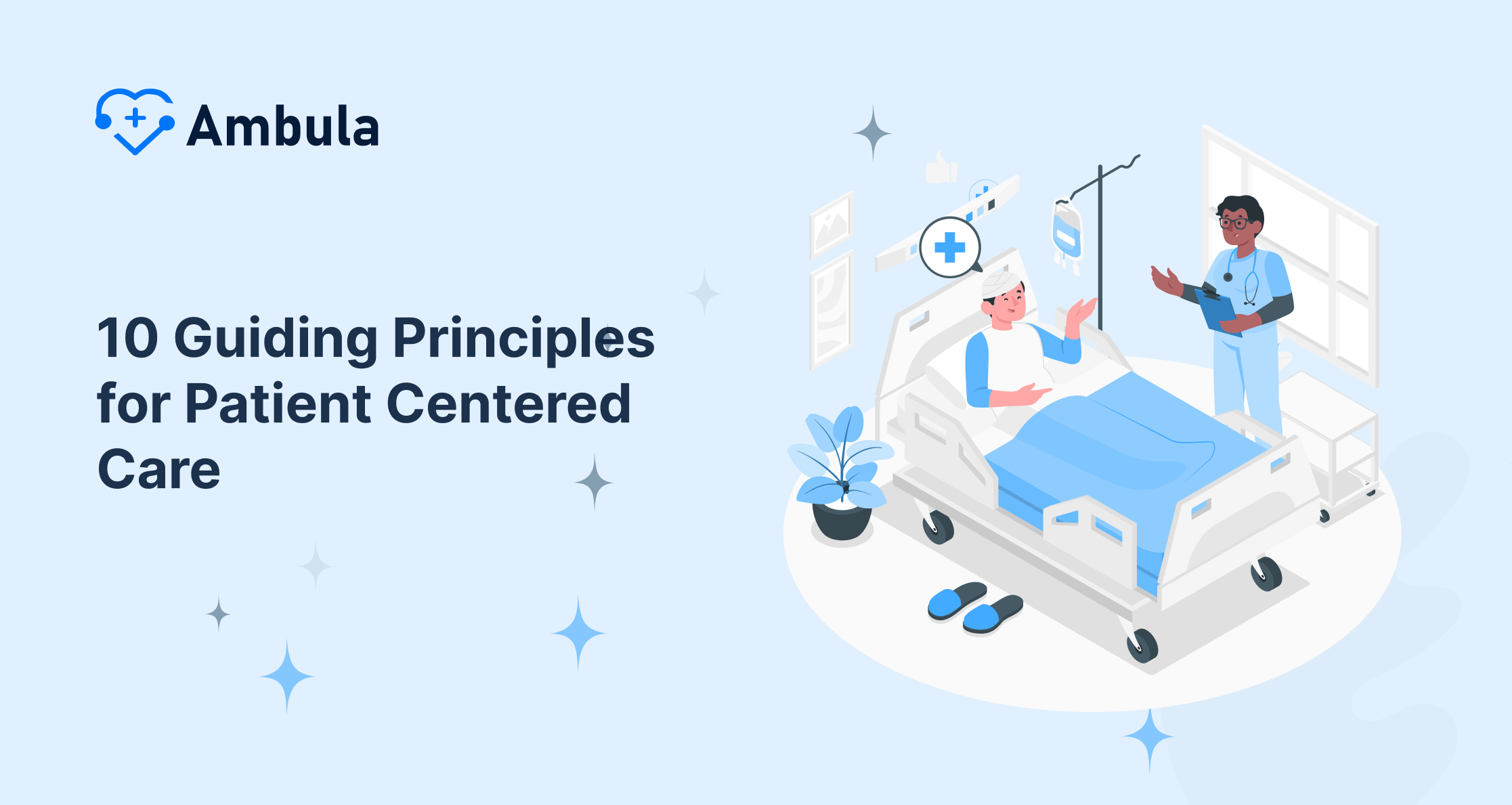
Today, we will unravel the fascinating concept of patient-centered care, also known as person-centered care or client-centered care. It’s a healthcare approach that treats patients as full participants in their healthcare journey, following key principles of patient-centered care. And let me tell you, it’s revolutionizing the patient experience powerfully. Hop in, and let’s explore the 10 guiding patient-centered care principles of this transformative healthcare approach, with some principles of patient-centered care examples along the way!
1. Respect for Patient’s Preferences and Values
Our first checkpoint is all about respect for patients’ values and preferences, one of the core person centered principles. Imagine how empowering it would feel to be actively involved in healthcare decisions. In the patient-centered approach, patients become partners with their medical professionals and care team. They are encouraged to express their values and preferences, which are incorporated into their personalized care plans to provide an individualized healthcare experience.
Imagine entering a doctor’s office and being greeted by a care team member who values your input. They ask you questions about your lifestyle, your preferences regarding treatment options, and what health goals you aim for. Doesn’t that sound like a pleasant patient experience? It’s all about respecting our differences, choices, and needs – a key aspect of what is person-centred care.
Respect for patient’s values and preferences is not merely one of the principles of person centered therapy; it’s an empathetic approach that encourages patients to engage fully in their treatment journey. It’s about honoring their autonomy and making them feel acknowledged, listened to, and understood.
2. Emotional Support
Let’s talk about emotional support – an often underestimated yet critical element of patient centered care. Healthcare can sometimes be a stressful experience filled with uncertainty and concern. Where does emotional comfort fit into this?
Well, emotional support in patient-centered care is all about addressing those fears and providing reassurance to patients through compassionate communication. It’s about forming a bond of trust so patients feel safe to express their concerns and know they’ll be met with understanding and empathy from their care team.
You might be worried about a procedure, afraid of potential side effects, or distressed due to a chronic condition. Patient-centered care professionals are trained to respond to these situations with genuine empathy and emotional support. They let you know that it’s okay to be scared and that they’re there for you in this process. Remember, you’re not just a number in the queue; you’re a person with feelings, and in a patient-centered model, these feelings are acknowledged and validated.
Remember the importance of compassion in the healthcare setting. A kind word, a patient ear, and the space to express feelings can all help create a hospitable and welcoming environment for patients.
3. Physical Comfort
Next on our journey through the principles of care is physical comfort. Can we agree that there’s nothing worse than feeling physically uncomfortable, especially when you’re ill? It’s already a challenging time. Why add discomfort to the list?
Patient-centered care sets a precedent for prioritizing physical comfort. This could mean effective pain management, restating hospital stays, or simply ensuring a pleasant treatment environment. Communicate with your care team if something is causing you physical discomfort.
In a patient-centered scenario, healthcare providers make a conscious effort to make you as comfortable as possible. No request or feedback is dismissed as trivial. Whether it’s something as simple as getting an extra pillow or adjusting the room temperature, every bit of input towards improving physical comfort is taken into account.
Let’s not forget patient access here. Timely and appropriate addressing of discomfort or pain is ensured in patient-centered care. You won’t have to endure long telephone hold times or jump through hoops to get the help you need for physical comfort.
4. Information, Communication, and Education
Getting crystal clear information and education about your health condition or treatment can sometimes feel like decoding hieroglyphics – confusing and intimidating. That’s where the patient-centered approach shines. It places a heavy emphasis on information, communication, and education to promote health literacy.
Imagine having your doctor explain your condition in straightforward, easy-to-understand terms. Information sharing in patient-centered care ensures you understand everything without feeling overwhelmed. This way, you are adequately equipped to engage in shared decision-making about your care.
Communication is a two-way street in patient-centered care. You’re not supposed to sit and take in whatever the doctor says. Feel free to ask questions or express your concerns. Patient-centered care advocates for active conversations between patients and healthcare providers. As part of this process, healthcare providers must provide resources for effective patient education and ensure they fully understand the information.
5. Continuity and Transition
Ever felt like you’ve just passed from one doctor to another without anyone understanding your complete health story? Lack of proper continuity and transition in care can lead to this feeling of being placeless and disoriented.
Continuity and transition in patient-centered care bear the promise of seamless care transitions. Your healthcare journey is seen as one continuous story rather than disjointed appointments and sessions. It’s about ensuring a smooth transition from one phase or professional to the next.
Whoever steps in at any point of your healthcare journey should know your story, where you come from, and where you’re headed. This promotes stability and consistency, enhancing the patient experience by making you feel understood, recognized, and tracked. That’s the real role of patient-centered care – ensuring that regardless of where and who treats you, your care feels like a harmonious symphony rather than awkward, uncoordinated, disjointed notes.
6. Coordination of Care
Our journey through the principles brings us to care coordination and care integration. We all love it when things flow smoothly without hiccups, don’t we? The same applies to healthcare.
Imagine a scenario where your primary care doctor, specialist, and pharmacist work together like a well-oiled machine as part of a coordinated care team. Each knows what the other is doing, and all are working towards your well-being through effective care management. This eliminates treatment overlaps, reduces the chance of miscommunication, and ensures everyone is on the same page.
Not only does coordinated care foster efficiency, but it also enhances the patient experience in meaningful ways. It prevents you from repeating your health history to every new healthcare professional, ensures timely and comprehensive care, and facilitates a smooth journey through the healthcare system.
7. Access to Care
As we delve further in, we land on another cornerstone of patient-centered care – access to care. Would you believe me if I told you that easy access to healthcare is still a challenge for many? Even in this modern era where you can book a flight, order food, and rent a movie, all with one tap on a screen, some still struggle with getting basic healthcare services.
Patient-centered care, however, strives to address this issue by making healthcare options not just accessible but easily accessible. For instance, it might mean extended clinic hours, online consultation options, or reduced wait times for appointments and procedures.
The role of patient-centered care here is to ensure that you spend less time chasing paperwork and more time engaging with your healthcare. It’s about bringing healthcare to you, regardless of your circumstances.
8. Family and Friends Involvement
Wouldn’t having your loved ones involved in your healthcare journey be comforting? If you agree, you’ll appreciate the involvement of family and friends in patient-centered care, one of the key principles outlined by the Picker Institute.
Healthcare professionals in this model understand and respect the role your loved ones play in your health journey. They are seen as allies in care, not outsiders. Whether arranging family conferences, encouraging visits during hospital stays, or including them in healthcare discussions, every effort is made to facilitate this involvement.
Like healthcare professionals, your loved ones have a unique understanding and insight into your health needs, preferences, and concerns. Their involvement offers emotional support and ensures that you always have advocates by your side throughout your healthcare journey.
9. Cultural Respect and Sensitivity
We all have our cultural beliefs and practices, which are part of our identity. But did you ever think about how these factors apply to your health?
Patient-centered care states that your cultural considerations matter within healthcare, too. Be it dietary preferences, spiritual beliefs, or language concerns, everything deserves respect and accommodation.
Healthcare staff in patient-centered care are trained to respect your cultural beliefs and person centered values. They provide culturally appropriate health education and communication, which enhances the patient experience in sensitive yet empowering ways. Health is more than just physical well-being – it also encompasses your cultural identity and beliefs.
10. Patient Participation and Involvement
Finally, the most important principle of all – patient participation and involvement. The patient-centered model, also known as patient directed care, revolves around this core principle, transforming patients from passive recipients into active contributors in the healthcare process.
Involvement means being in the driver’s seat of your healthcare journey. You’re not just vague info. It’s about making you an equal and active member of the healthcare team. It’s liberating, not intimidating. Remember, your opinions, preferences, and inputs matter! This collaborative decision-making approach is a hallmark of patient-focused care examples.
The opportunity to actively participate gives you a sense of control over your health. It motivates you to be proactive and accountable for your health outcomes, resulting in greater patient empowerment, patient engagement, patient satisfaction, and overall care quality – all key elements of patient centered care.
And that rounds up our tour of the 10 principles of patient-centered care. Each principle emphasizes promoting the patient experience, access to healthcare, and the core role of the patient-centered care model in modern healthcare. Trust me when I say that once you’ve experienced this model of care, there’s no going back! So, let’s embrace these principles, raise the bar for healthcare, and create a world where every patient feels heard, understood, and cared for through a holistic view and strong patient-provider relationships.






